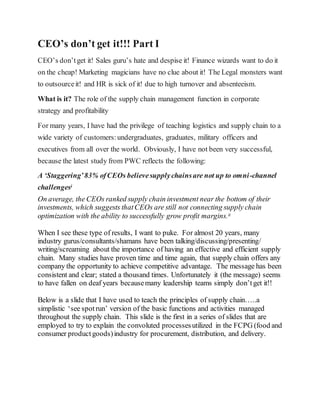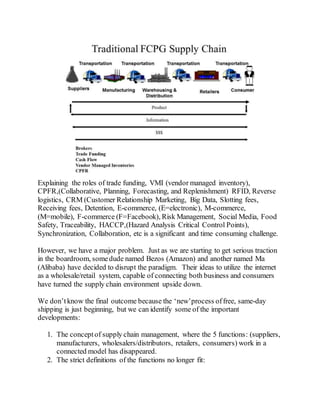Ceo's dont get it
- 1. CEO’s don’t get it!!! Part I CEO’s don’tget it! Sales guru’s hate and despise it! Finance wizards want to do it on the cheap! Marketing magicians have no clue about it! The Legal monsters want to outsourceit! and HR is sick of it! due to high turnover and absenteeism. What is it? The role of the supply chain management function in corporate strategy and profitability For many years, I have had the privilege of teaching logistics and supply chain to a wide variety of customers:undergraduates, graduates, military officers and executives from all over the world. Obviously, I have not been very successful, because the latest study from PWC reflects the following: A ‘Staggering’83% ofCEOs believesupplychainsare not up to omni-channel challengesi On average, the CEOs ranked supply chain investment near the bottom of their investments, which suggests thatCEOs are still not connecting supply chain optimization with the ability to successfully grow profit margins.ii When I see these type of results, I want to puke. For almost 20 years, many industry gurus/consultants/shamans have been talking/discussing/presenting/ writing/screaming about the importance of having an effective and efficient supply chain. Many studies have proven time and time again, that supply chain offers any company the opportunity to achieve competitive advantage. The message has been consistent and clear; stated a thousand times. Unfortunately it (the message) seems to have fallen on deaf years becausemany leadership teams simply don’tget it!! Below is a slide that I have used to teach the principles of supply chain…..a simplistic ‘see spotrun’ version of the basic functions and activities managed throughout the supply chain. This slide is the first in a series of slides that are employed to try to explain the convoluted processesutilized in the FCPG (food and consumer productgoods)industry for procurement, distribution, and delivery.
- 2. Explaining the roles of trade funding, VMI (vendor managed inventory), CPFR,(Collaborative, Planning, Forecasting, and Replenishment) RFID, Reverse logistics, CRM (Customer Relationship Marketing, Big Data, Slotting fees, Receiving fees, Detention, E-commerce, (E=electronic), M-commerce, (M=mobile), F-commerce (F=Facebook), Risk Management, Social Media, Food Safety, Traceability, HACCP,(Hazard Analysis Critical Control Points), Synchronization, Collaboration, etc is a significant and time consuming challenge. However, we have a major problem. Just as we are starting to get serious traction in the boardroom, somedude named Bezos (Amazon) and another named Ma (Alibaba) have decided to disrupt the paradigm. Their ideas to utilize the internet as a wholesale/retail system, capable of connecting both business and consumers have turned the supply chain environment upside down. We don’tknow the final outcome because the ‘new’process offree, same-day shipping is just beginning, but we can identify some of the important developments: 1. The conceptof supply chain management, where the 5 functions: (suppliers, manufacturers, wholesalers/distributors, retailers, consumers) work in a connected model has disappeared. 2. The strict definitions of the functions no longer fit:
- 3. a. Manufacturers have opened retail stores and/or web sites to sell direct to consumers via the web. Suppliers such as farmers regularly participate in retail sites (farmers markets); they also deliver direct to consumers supported by sophisticated websites that take orders, schedule deliveries and provide for electronic payment. 3. The old linear supply chain has evolved because consumer now has the tools to access all of the functions, 24/7/365. The system is now circular with the consumer driving the activities. 4. There are no rules! Companies, individuals, and organizations can create new systems and concepts quickly as the barriers to entry are low with the rules of engagement still to be written. Going forward, the corporateboard rooms need to wake up or face the spiral of death, where new agile, innovative companies, and entrepreneurs, successfully try new concepts. Thesenew players take sales away from the old companies who don’tget it, slowly bleeding their profitability, which ultimately leads to death. i PWC study: Retails New Imperative, Forbes Insights/JDA2014 ii PWC study: Retail’s New Imperative, Forbes Insights/JDA2014



